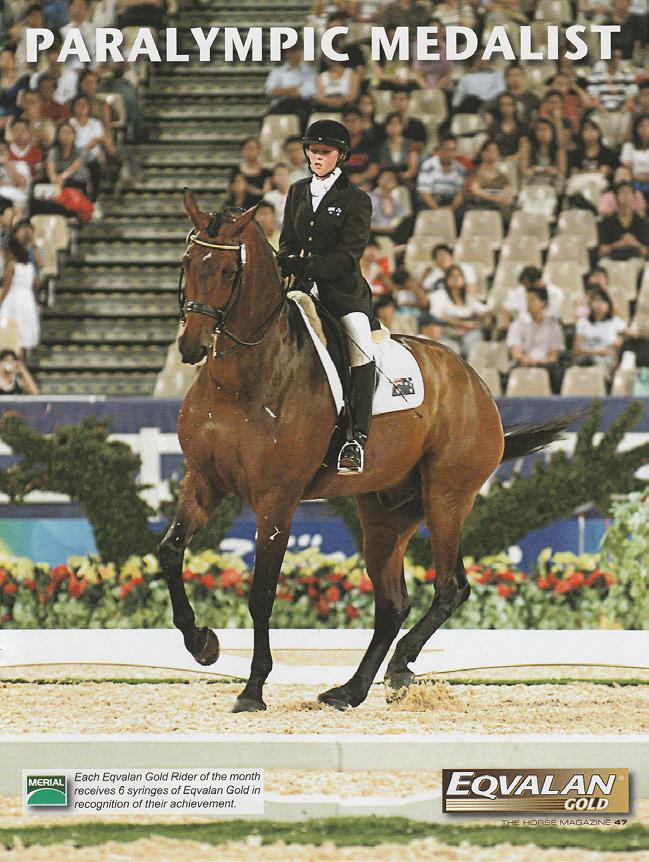
17 minute read
Spotlight on Clicker Training
SPOTLIGHT
Click goes the clicker girl, click, click, click
Two-time Paralympian Georgia Bruce has taken clicker training to a whole new level in Australia CANDIDA BAKER writes.
Imagine having a horse that can play croquet, paint a picture, lie down, fetch, do piaffe, flying changes, Western pleasure, trail-riding – oh, and take turns lunging you.
Perhaps you might think I’m talking about a fantasy unicorn, and not an actual horse, but no, clicker-trainer Georgia Bruce’s Rumba the Wonder Horse, actually can do all of these things – and more.
But it’s one thing to see Georgia giving her graceful, joyful, fun-filled demonstrations (although these days Rumba has settled into a gentle semi-retirement on Georgia’s property) and another to fully comprehend the work that goes into what seems so easy.
Georgia’s work these days is the culmination of a lifetime with horses, and, it seems, it’s in her DNA.
“My mum loved horses,” she tells me in some rare downtime from her horse business. “She grew up in Williamstown in Victoria, and when she went to New Zealand, she rode trackwork there, and also worked for T.J. Smith back in Australia. I think I just inherited that love of horses, and all animals, from her. When I was growing up we lived in North Queensland, and I was desperate for a horse but I didn’t have the opportunity to get one until I was 12, after I’d worked as an extra on the mini-series Ocean Girl, when I saved up and bought my own horse.”
There were a few odds stacked against Georgia right from the start. She was born without a radial bone in one arm and no thumb on that hand, due to aerial spraying of Agent Orange, the toxic defoliant used to turn rainforest into cattle fields. “There were four babies born at the same time with similar disabilities,” she says, “but we never could call the companies to account because of the cost of it. In Vietnam, where Agent Orange was used in the war there were a lot of people born with disabilities similar to mine.”
But the lack of a fully-functioning arm didn’t lessen her passion for horses, and with her mother working in a local riding school, by the time Georgia was seven she was learning to ride.
“When the time came that I could afford my first horse, Mum had it in her head that she wanted me to get a Quarter Horse that was trained for reining, and she found a horse that had done roping who seemed really quiet. When we got him home, he was really skinny, and covered in ticks, and as soon as he put weight on he bucked constantly and went backwards everywhere! That’s how I got into training horses.”
A lot of people might have given up straight away, but Georgia with the help of her dressage and horsemanship coach, Geoff Blacklock, gradually turned Dan around. “We went on to win in Western Pleasure, trail, horsemanship and reining,” she says. “It was eventually rewarding, but he was a challenging horse.” She pauses and laughs. “Perhaps it was a good thing for my future career that I thought all horses were like that!”
Her success with a difficult horse attracted some attention, and she started helping people with their horses, and giving a few lessons. “I had a friend at the time who was great at finding out information, she’d come across the clicker training, and she’d taught her pony to fetch, which I thought was really cool. I could ride horses without a saddle or bridle, I could do liberty but I couldn’t teach them to fetch.”
At the time Georgia’s main equine companion in her work was Crystal, a very sensitive Andalusian/Arabian cross mare, and Georgia was intrigued enough to incorporate clicker training into their regime. “I taught her to fetch, play soccer,
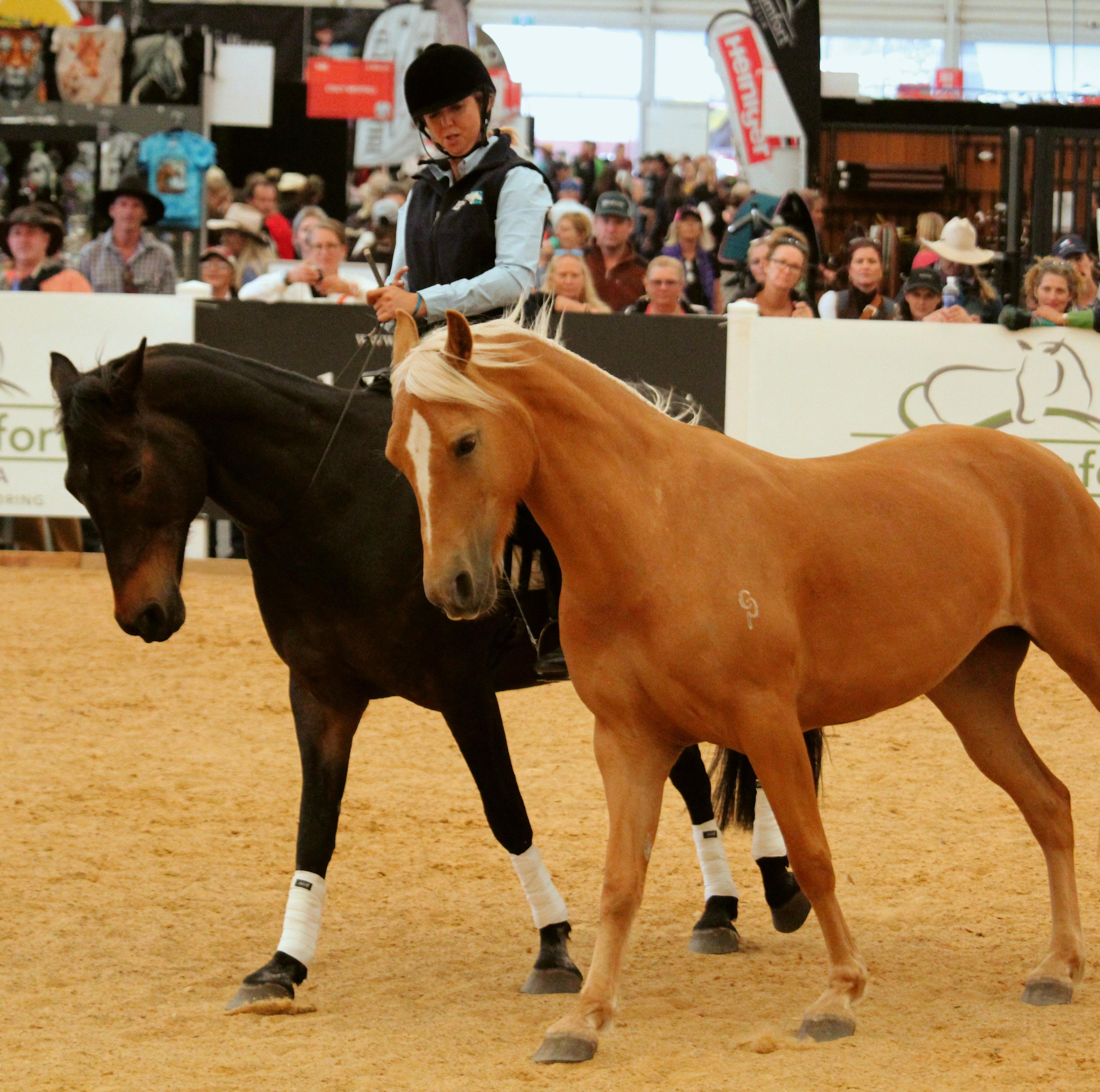
Georgia, Rumba and Angel demonstrating clicker training at Equitana 2018. Photo: Michelle Knoll Photography.
and do the Spanish Walk, but I still wasn’t really thinking of it as a way of teaching mainstream movements,” she says. “It was my friend Jill who suggested we try using the clicker with flying changes – so we did.”
Success ensued, so much so Georgia was impressed with how calmly the horses learned. “Previously I’d used natural methods but the horses still got a bit revved up during the learning process, but with the clicker – stop, reward, rest – our two horses picked it up very quickly. We said to each other: ‘This is cool!’, and basically I haven’t looked back.”
What clicker training gave Georgia was what she calls ‘clarity’ around what she was asking. “Normally most types of training use a form of pressure and release,” she says, “but when we add in the clicker, we mark the right response with a click and give them a food reward –then they become really motivated. They put the marker, the behaviour, the reward together and you have a horse that wants to learn, and actively enjoys the process. It has a flow-on effect because the more they learn, the more they love it, the easier it gets, and once they have learned a behaviour you can phase out both the clicker and the reward, and just use it every now and then.”
The somewhat counter-intuitive idea for those of us who have ever been pushed around by a horse searching for a treat, is using a treat to give horses manners around food, and it’s probably the most misunderstood thing about clicker training, Georgia believes, so that many people think that clicker training will simply make a horse look for food.
“It’s actually quite the opposite,” she says. “The very first thing we teach is manners around food. I set them up for success, with the horse behind a fence so they can’t barge into me. I stand with the food pouch, and of course they sniff at it, but then at some point when I don’t give them a treat, they’ll quit sniffing and move their head away from me. That’s when I mark the behaviour, instantly, click, then treat, and gradually increase duration. The clarity of the message is ‘stand out of my space, you don’t need to come over and mug me’. The second thing, as with natural horsemanship is to get your horse to move backwards away from you, with the click, reward and rest you don’t need to escalate the pressure, you’re simply shaping the behaviour until the horse understands, and pretty soon the horse is backing away easily. I suppose I would sum it up by saying that with pressure and release it can take a horse a long time to come to the party, clicking and rewarding gets them wanting to do the behaviour.”
Part of Georgia’s ability to ride horses in a remarkably light frame comes she thinks, from the missing bone in her arm. “The fact is that I have to create horses that are light and responsive because I just can’t have them pulling me around.”
In fact, as with everything she’s done, her entry into the world of high-level dressage was filled with some interesting turns and twists. “I started doing dressage with Crystal,” she says, “and to be honest I didn’t know much about it. When we’d just started I had to have an operation on my shoulder and I couldn’t ride for a whole year, and I had to have my arm in a sling, so I got really good at liberty training, and as soon as my shoulder healed I got back into dressage but with a lot more understanding. I started doing really well, and someone said to me, ‘you could go to the Paralympics’. Well, that gave me a
And up they go! Rumba on the left and on the right Kalimna Prestige. Photo: Sage Carlson.
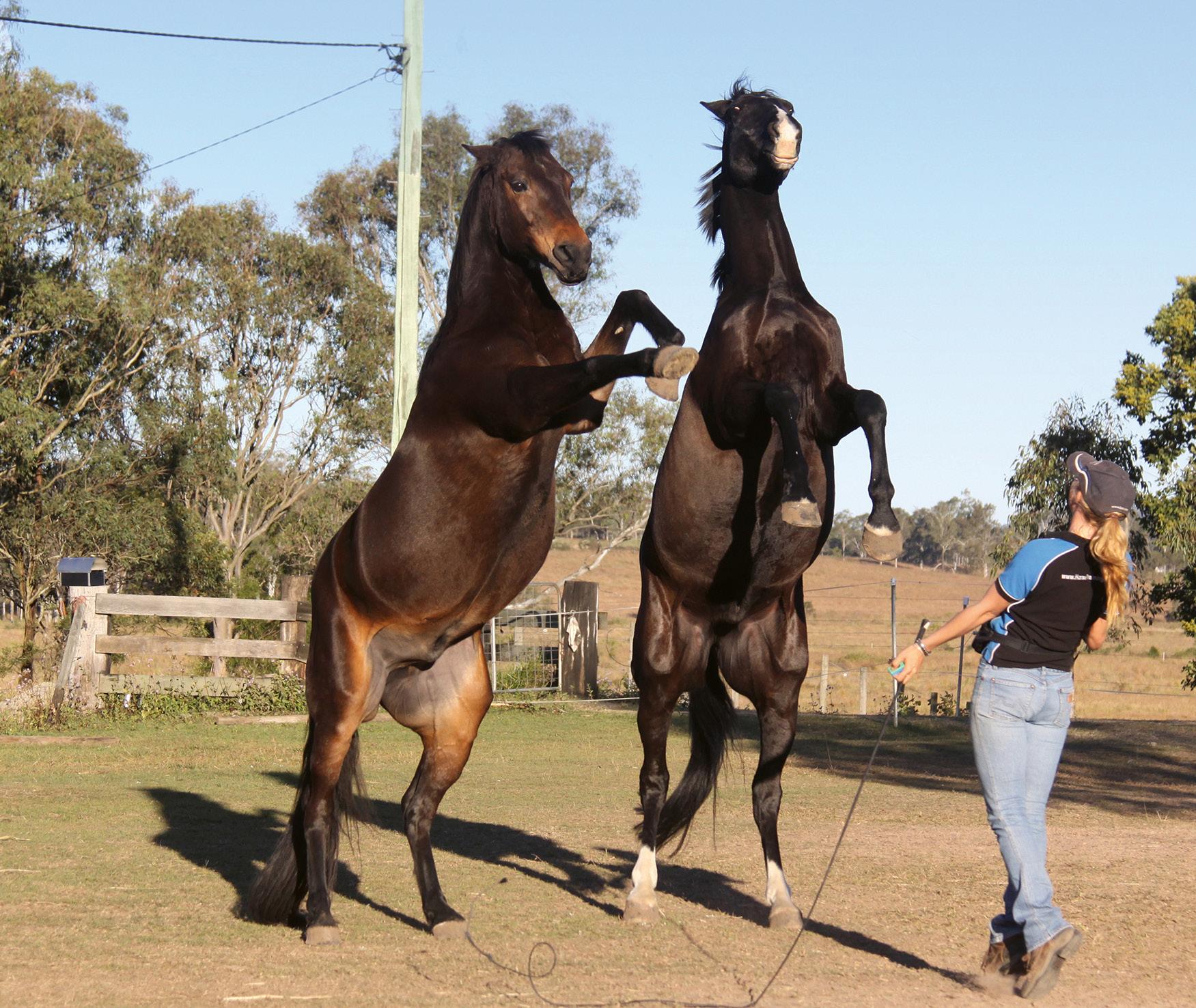
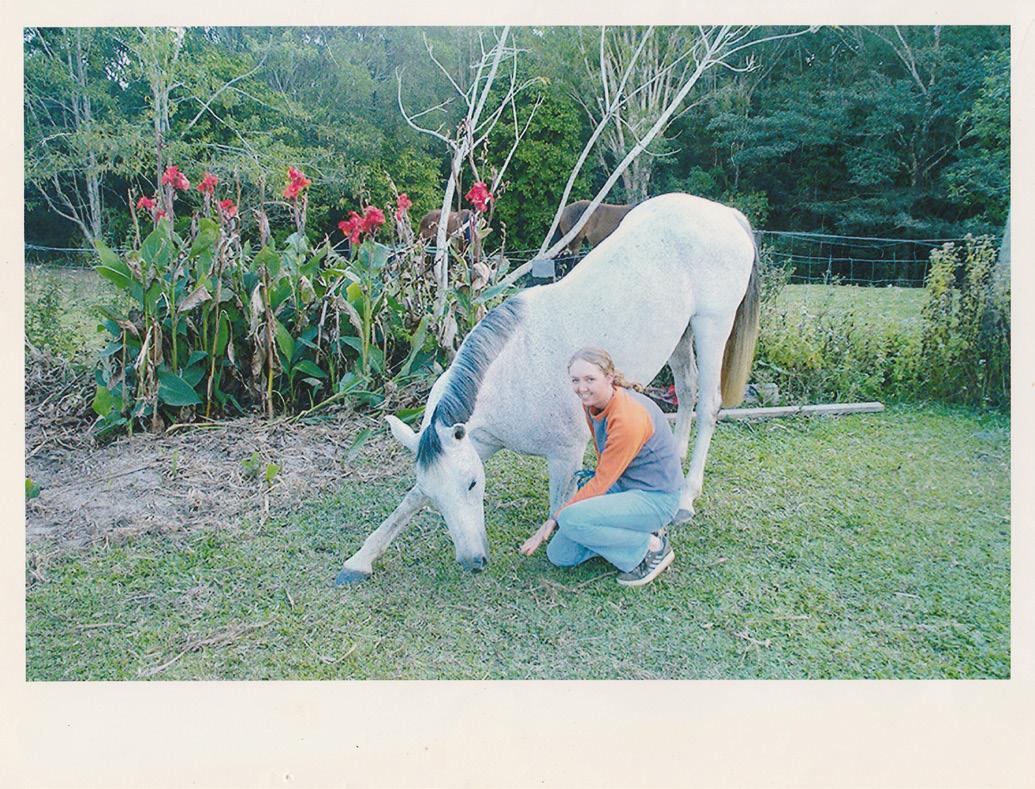
pause because I’d never thought of myself as disabled!”
But giving the idea time to sink in, Georgia realised that it would be a great opportunity to travel and get some great teaching from high-level instructors, so she trained towards the selection trials. She just missed out on being selected for the Sydney Olympics in 2000 with the selection committee saying that at 19, she was too young.
“I did a test ride for the judges,” she says, “and we had to ride pool horses, so one of the horses that hadn’t been picked I got. I actually did so well I scored higher than some of the Australian team and another country took the horse I was riding straight away.”
But from 1999 to 2009 was a massive decade for Georgia internationally. She was on the Australian Paralympic national squad, and the para-dressage squad, competing 12 times internationally, at two World Championships, in Belgium in 2003 and England in 2007, and at two Paralympic Games, Athens in 2004, where she just missed out on a medal, and in the 2008 Beijing games, where the horse events were held in Hong Kong, and she won two bronze medals riding Victory Salute, owned by Carolyn Lieutenant.
At around the time of her international career taking off, Georgia also had a very talented big Warmblood, Astro, in training for the World Equestrian Games, but he sadly came down with asthma and had to retire from competition. “It was again a bit of good timing because I’d started focussing on teaching, and suddenly I was doing clinics and clicker-training, and teaching western dressage, trick training and liberty training,” she says. “I took Rumba the Wonder Horse all over Australia doing trick shows. He could liberty grand prix on the ground, and do tempi changes and canter pirouettes with or without me on his back.”
Living up to his name however, that’s not all he could do. He was also a dab hand (or hoof) at abstract art, he’s got his own FB pages, and two videos of him have gone viral. “The one of him tucking himself into bed has been viewed 50 million times, I think,” says Georgia, “although I’ve actually lost count. I also did a Git Up challenge that’s had several million views, and we were educators at Equitana five times.” to move away from Queensland and concentrate her horse life further south, somewhere where she could also continue to build on her very successful career as an entrepreneur, putting out her first book in 2004, which was followed by a DVD series.
It strikes me, yet again, what a phenomenal young woman Georgia is – plunging into the world of videos and marketing with never a second thought. “I wouldn’t say it’s in my nature to market myself,” she tells me, “but I knew I had to teach myself, so I taught myself video editing and I learned how to promote the videos – I have to research each stage of any project but it’s been rewarding.”
As she continues to build her online presence through an online course, and with access to her video library, offline, out in the horse world, she has a beautiful Warmblood, Joey, who is currently training at medium level in dressage, and a Welsh-Cob/Arabian/Warmblood, Angel, she’s currently doing dressage, liberty and tricks with.
And then, of course, there’s Rumba. “He has a wonderful life,” she says. “He gets worked lightly so he is stimulated and entertained, but he is looked after like the retired star he is.” What’s the betting that it won’t be long before Georgia trains another ‘Wonder Horse’?
Georgia working Rumba (inside) and Kalimna Prestige at liberty.
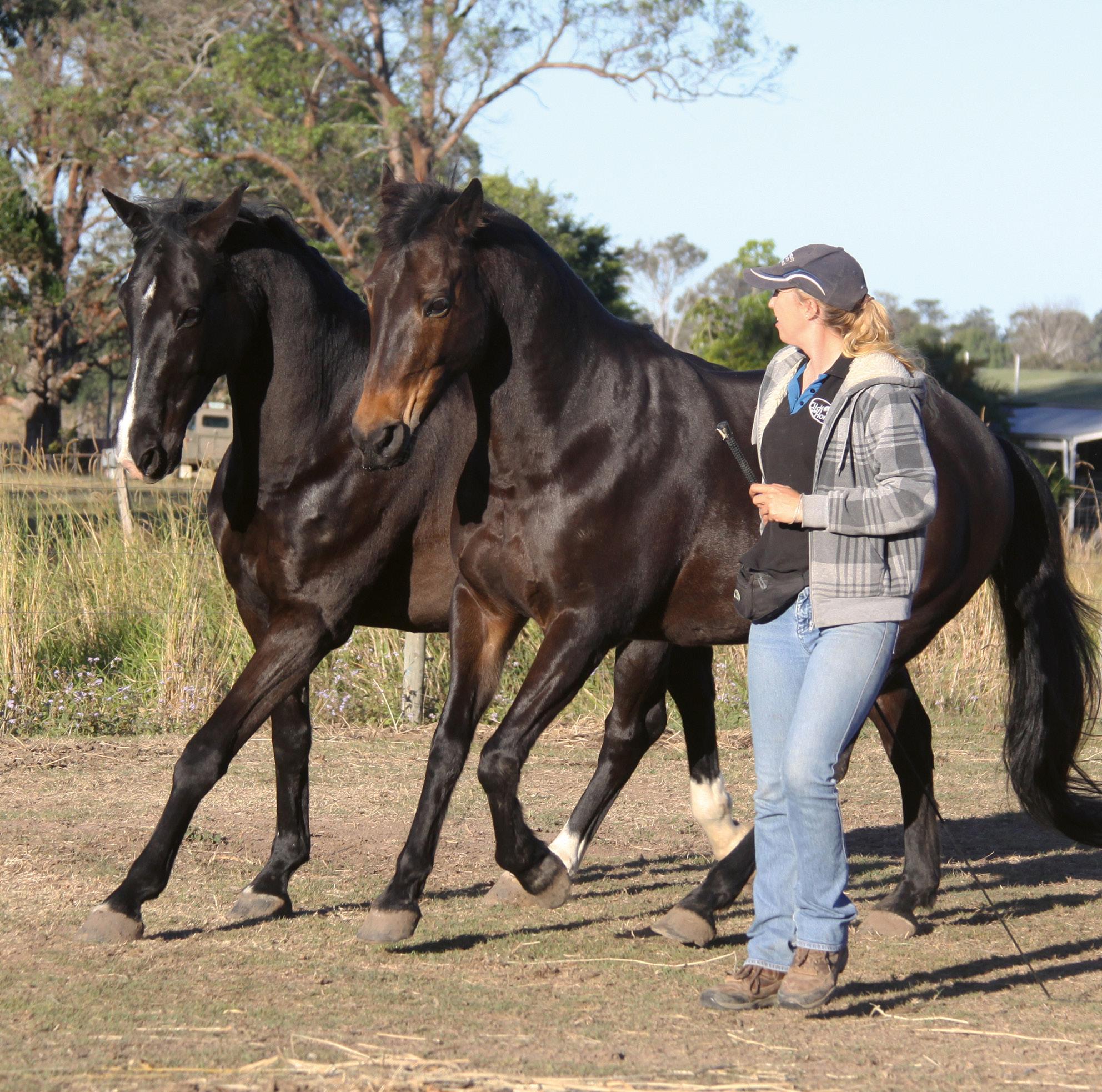
Hercules & Susi’s extraordinary journey
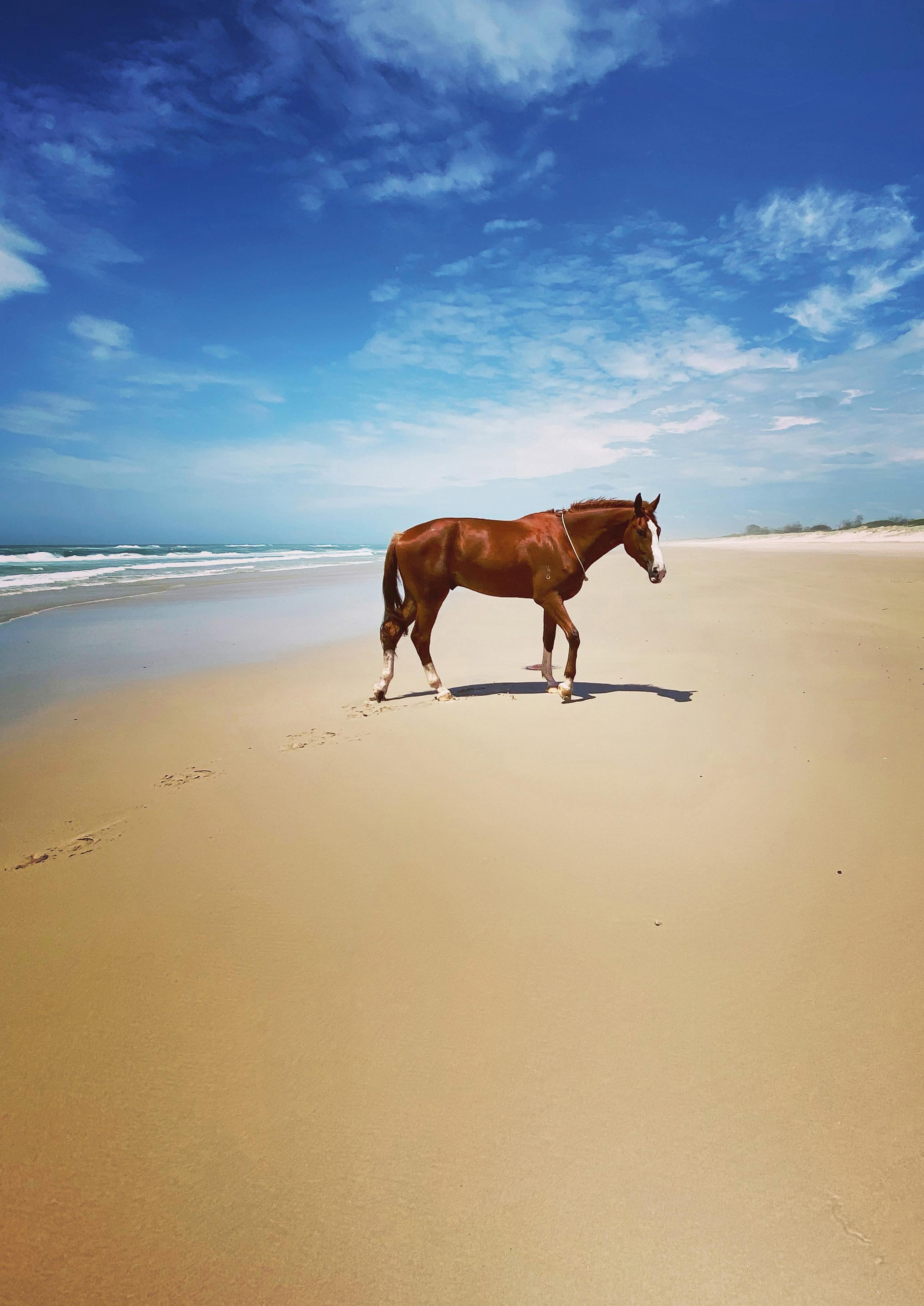
When a gangly young Warmblood came trotting into clicker trainer Susi May’s life nine months ago, little did she know just how quickly the bond between them would grow, CANDIDA BAKER writes.
OPPOSITE: Hercules enjoying his liberty, still focussed on Susi. THIS PAGE: A click and a reward after a canter on the beach. INSET: Teaching Hercules the Spanish Walk. Photos: Candidia Baker.
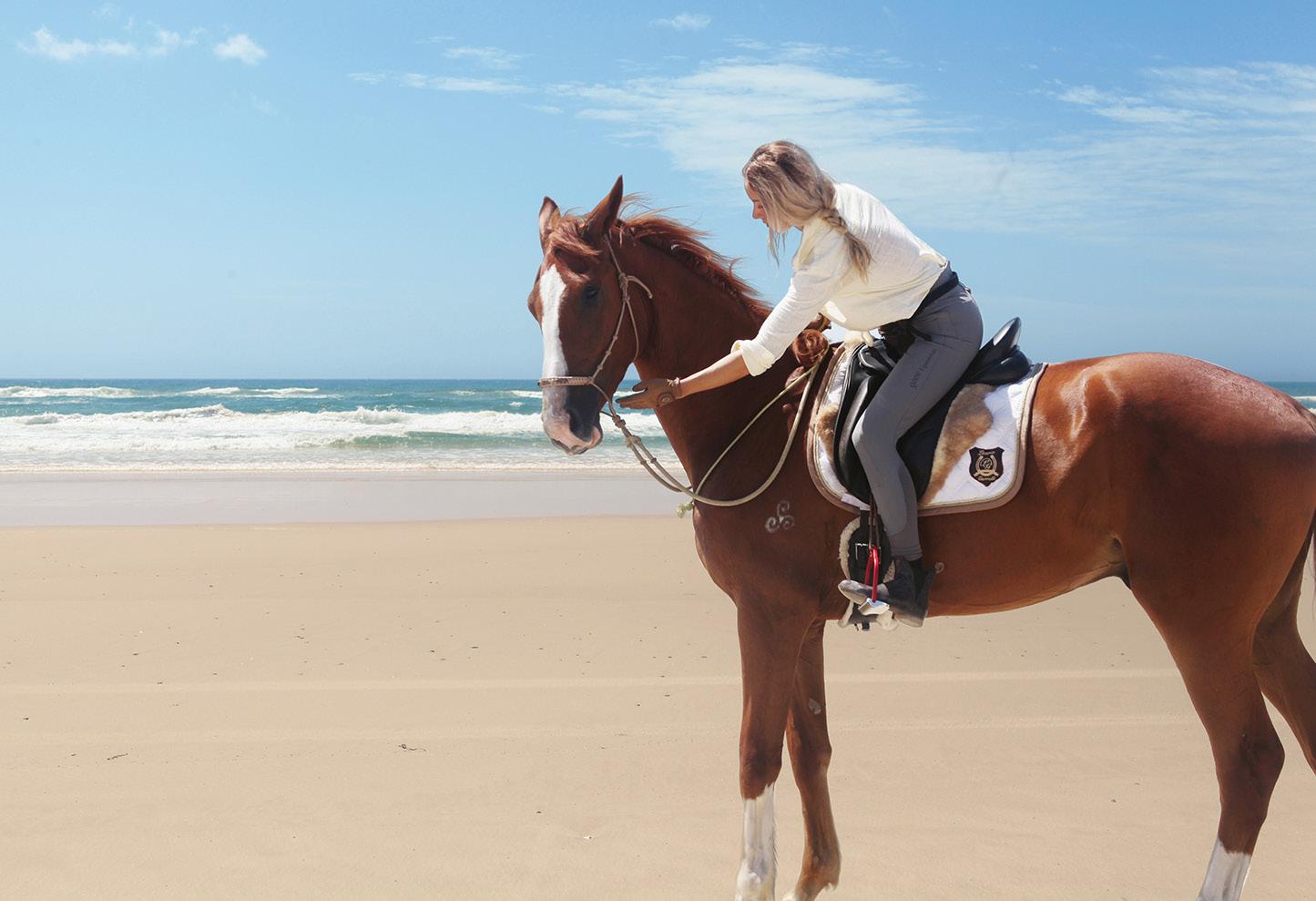
Susi May, her horse Hercules and I are walking along the beach. It’s a perfect day. The sun is shining, there’s not a cloud in the sky; the sea and sky are as blue as can be. We’re chatting away about this and that, when suddenly it dawns on me that Hercules, Herc for short, is actually loose beside us. As in nothing on him of any description.
He’s just mooching along, eavesdropping over Susi’s shoulder, having a lovely time.
I honestly can’t quite believe what I’ve witnessed over the past few hours, and not for the first time it makes me aware of how complicated we often make our relationship with horses.
Susi credits her success with Hercules to clicker training, something she learned from her coach seven years ago and has used ever since to start, train and educate horses.
“What I love about clicker training is the connection and the communication that is established. The best whisper is a click,” she says. “Coordination and timing can be tricky and it isn’t something you can learn overnight, but clicker training is an amazing tool. The first very important step with clicker training is to get the horse to stay out of your space, you teach them they are not to receive their treat inside your personal bubble.”
Born in Austria to parents from the Czech Republic, the family was sponsored to Australia when Susi was five. Between the ages of five to 12, Susi and her mother moved frequently. But even though there wasn’t a sign of a horse on the horizon during those years, Susi can’t remember a time when she wasn’t horse-obsessed.
“I was obsessed even as a baby,” she says. “My grandmother used to give me little felt horses, and I loved them. I think it was just beamed into me this lifetime. I didn’t just ‘see’ them, they were literally inside me, and I just desperately wanted a horse.”
Fortunately when she was 12, the family moved to a property near Toowoomba, and Susi got her own horse, starting her mother on her horse journey as well.
But when she was 16 her life changed direction for a while. She left home, and after a year saving money backpacked around Australia fruit-picking and doing seasonal work for three years.
For a youngster on the move, life wasn’t always easy, and at one point Susi fell on hard times, living under a bridge with five Canadians, working when she could, and even resorting to pinching food if she had to in order to survive.
“One evening I remember I had this packet of two-minute noodles, and I had no way to prepare them, except to try cooking them on a barbecue in the park. There was a Kiwi family making dinner nearby and the smell of their food made my mouth water. When they came over and asked me if I’d like to eat with them, I couldn’t believe it. My Canadian friends were so mad at me when they realised I’d just eaten a meal!”

to live forever. After a bout of illness, Susi went home to recuperate, and to contemplate her next move.
Inspired by the kindness of the Kiwis in the park, she decided to move to New Zealand when she was 19, and for two years worked in hospitality before eventually coming home.
“I came back to Australia with the intention of creating a good career for myself,” she says, “and I landed a job as stewardess on a cruise ship when I was 21. I’d promised myself after New Zealand that I wasn’t going to date any more New Zealanders, but then as fate would have it I met Sam, and he was a Kiwi too! We’ve been together ever since – for fourteen years now. I worked my way up to purser on the cruise ships, and Sam now works on oil and gas rigs.”
After travelling the world together, working on cruise ships and yachts, they got to a stage where they wanted a more settled life. The couple bought a property together in Teven in the Northern Rivers, where Susi did an equestrian coaching certificate, working for the Byron Bay Equestrian Centre as a coach and at Tassariki ranch in South Ballina as a coach and trail guide.
“Finally I was able to get back into horses,” she says. “I bought Tommie, a Thoroughbred who’d been in Japan racing. They brought him back to Australia to retire him, and then decided to give him one last run in the Ballina Cup in 2008 – which he won!”
With Tommie, Susi started her clicker journey in earnest, and the ex-racehorse loved his new mixed life galloping along the beach one day, learning dressage the next. But life never remains static, and after Tommie had an accident, which damaged his wither, Susie had to reassess. “About eight months ago Hercules came into my life, and with our now fiveyear-old son Liam, and Sam being a FIFO husband, having two horses was difficult – especially with the drought, so Tommie retired to a property nearby, and Hercules and I began our clicker journey together,” she says.
And what a journey! This gangly, over 17hh three-year-old Warmblood whose hooves are the size of dinner plates is already attracting attention throughout the horse world with his endearing, quirky nature and his apparent ability to absorb information.
It all started, says Susi, with groundwork. “I actually didn’t even intend to start riding him this young, but Hercules literally almost asked me to get on him,” she laughs.
These days, at the age of three, Hercules is already a seasoned beach campaigner, and Susi has used the beach as her main training ground, because she says: “It’s such a great environment for horses because it’s stimulating, great for their bodies and their minds, and it’s a wide open space.” Perhaps this is where Susi and most traditional horse owners might differ slightly – because it’s exactly the wide open space that might, for me at least, set off a series of what if’s. What if the horse takes off? What if it doesn’t come back? What if it spooks at that truck coming down the beach?
But the proof is in the pudding, as they say, because Hercules, only eight months into his training, takes everything in his (massive) stride. He potters off from us occasionally, taking himself down to the water like a giant dog, then coming back for a click and a treat.
Over a couple of hours Susi and Hercules entertain, inspire and amaze me. She shows me how she’s teaching him to Spanish Walk. She rides him bareback with just a neck rope up the beach, she canters him with the saddle and the halter, and then with the saddle and bridleless. She swims with him. He rolls over for her and she sits on him in the sand, while he turns his head gently towards her. When we’ve finished playing – and there’s really no better word for it – and we’re ready to start walking back to Tassariki Ranch where Susi is based, Herc decides to knock her hat off, and it ends up flying down the beach with me chasing after it. To be honest I don’t know who was laughing more – Susi, or her horse.
But at least Hercules liked me. Apparently he doesn’t take to most people, but I’d gone armed with my essential oils, and Susi was impressed at the effect they had on Hercules, who was keen to indulge his sense of smell with a wide range of scents. He even let me give him a hug, so perhaps he was laughing with me not at me. Although I have my suspicions.
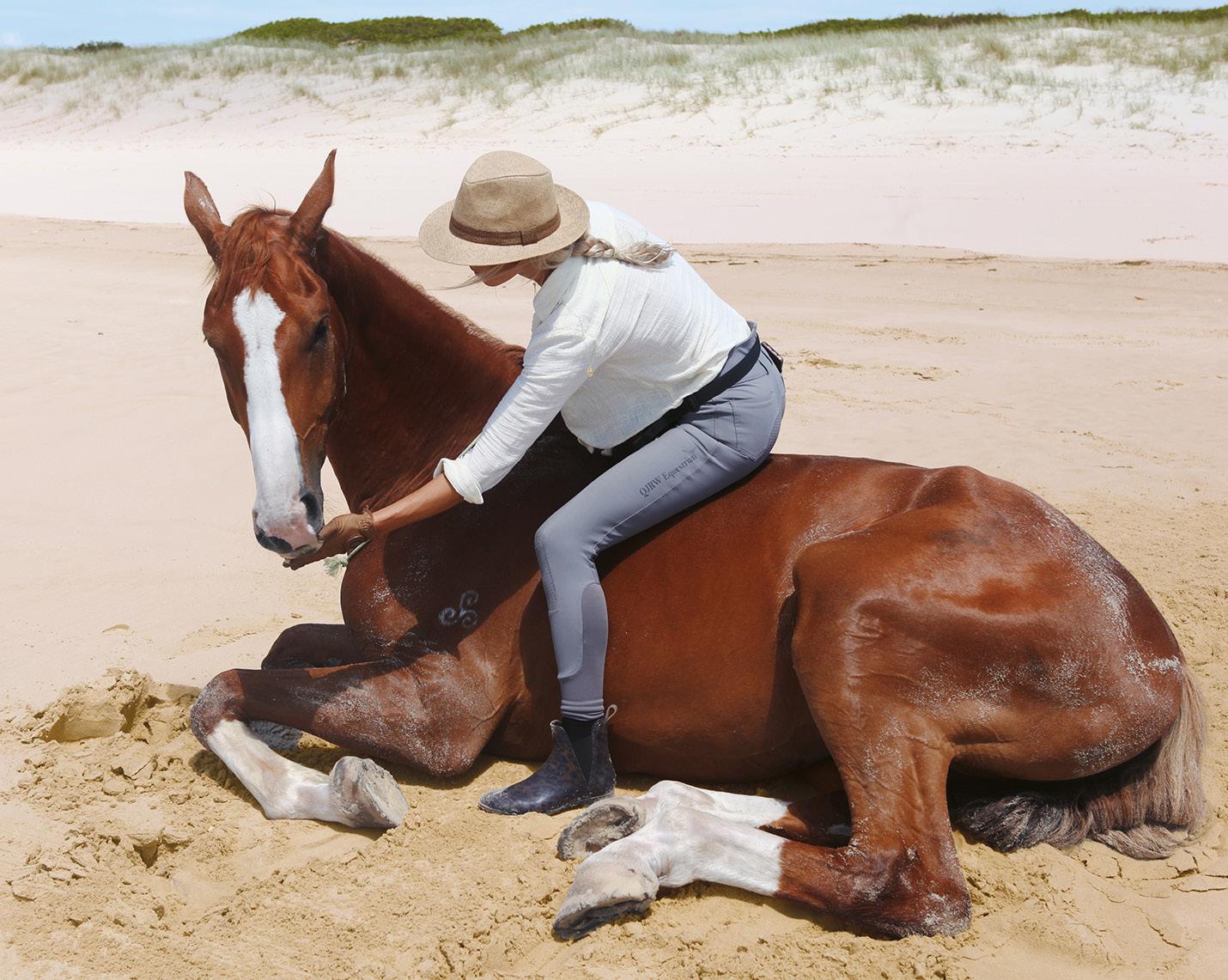
Best of friends – a post-swim roll, lie down and a reward. Photo: Candida Baker.
You can contact Susi May for clicker training via Instagram @Susimay22 or Facebook: Susi & Hercules Liberty Clicker Training or by email: susivitek@gmail.com










